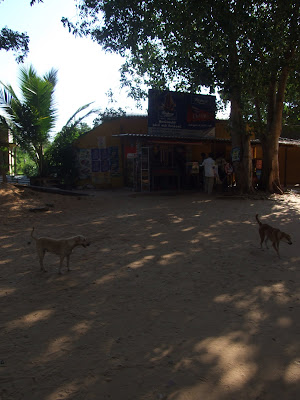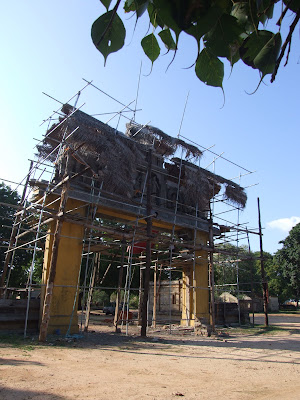
Sri Lankan visual artist Koralagedara Pushpakumara expanded his imagination by using the distance between North of Sri Lanka and South India ~ 22 Miles. He used 22 sacks of various groceries imported from South India to Sri Lanka
"Sethu Samudram" is a three year collaborative art project and a dialog~making platform between Theertha International Artist Collective, Colombo,Sri Lanka and 1 Shanthi Road in Bangalore, India.
"Sethu Samudram" is the name of the mythical bridge found in Raamayanam ~ meaning the bridge across the ocean. This bridge connects ri Lanka and India.
There is substantial amount of good reasons to believe the existence of a real "Sethu Samudram" ~ a bridge across the ocean ~ between the two geographies in the ancient times, not only conceptually but also physically. This naturally formed ancient bridge in the Palk Strait has acquired numerous mythical through millennia.
South India is only 22 miles across the Palk Strait from North of Sri Lanka. Considering the proximity of South India to Sri Lanka, even without much hard arguments, the possibility of cultural exchanges and human migration between these two geographical zones for millennia can be an obvious presumption.
Now a construction of a real human~made bridge is scheduled to be constructed linking Sri Lanka and South India on the same place where the ancient bridge was supposed to have been. The mythical bridge is under physical threat and is drawing critical attention from various interest groups mostly Indian. They are highlighting many opportunities and potentials as well as imagined ecological, social, political and cultural threats which might ensure from the building of this bridge.
"Sethu Samudram"~ the art project that Theertha and 1 Shanthi Road have developed collectively is envisioning to investigate this highly complex and variegated history and emotions surrounding the concept of "Sethu Samudram" and foreground the links, similarities and shared anxieties, emotions and histories between the two geographical areas. The overall research will cover a wide area of study that includes society, politics, history, religion and mythology as relevant to Sri Lanka and India. The "Sethu Samudram" project would like to engage in the wider discussion of history navigating through the contemporary ideological and methodological innovations of visual arts within the South Asian region. With this in mind, "Sethu Residency 1 @ Theertha 2010" is the very first research based art residency under "Sethu Samudram" ~ the art project held in Sri Lanka.
Participating artitsts are Koralagedara Pushpakumara (Sri Lanka), Madhu D (India), Pradeep Chandrasiri (Sri Lanka), Sharni Jayawardena (Sri Lanka) and V.G.Venugopal (India). The Sethu Residency 1 @ Theertha 2010 was inaugurated on 27th of December 2010 at the Theertha Red Dot Gallery in Pittakotte. The exhibition will remain open till 11th of January 2011. The gallery hours are Monday to Wednesday 10.30AM ~ 5.00PM and Sundays 11.00AM ~ 4.30PM.

Series of shirts by Indian artist V. G.Venugopal

Series of shirts by Indian artist V. G.Venugopal

In the Theravada Buddhist tradition female deities have been relegated to minor positions. An exception has been the Goddess Pattini. Sinhala Buddhist believe that Pattini is a guardian deity of Buddhism. She is the definition of Kannagi, who is the central character of the Tamil epic Silappadhikaram (Cilappatikaram). She is worshipped by mainly by Buddhists in Sri Lanka (and also Hindus in the East) and is the patron goddess of fertility and health.
According to Sinhala mythology, the Bodhisatva Pattini was incarnated as Kannagi to ride the Pandy Kingdom of its evil three-eyed King. She was born of a Mango fruit, which was cut down by the God Sakra with an arrow.
The first mention of Pattini is in the Silappadhikaram written in India sometime after 2nd Century CE. At the end of the Sangam Era (2nd to 3rd Centuries CE), the older order of the three Tamil dynasties was replaced by the invasion of the Kalabhras. These new kings and others encouraged the religions of Buddhism and Jainism. Ilango Adigal, the authour of Silappadhikaram, probably lived in this period and was one of the Jain and Buddhsit authours in Tamil poetry.
Gananath Obeysekere in his book Cult of the Goddess Pattini makes the point : "An examination of some of the Sinhala texts of the Pattini cult may provide further circumstantial evidence regarding Pattini as a Buddhist deity, both in the original South Indian context and the later diffusion of the cult to Sinhala Sri Lanka".
These are the verses I used (to elucidate the images):
When the time for offering mangoes arrived
And seeing that the mangoes were ripe
She covered them in cloth at he correct time
And offered them to the Buddha.
By the merit of the mango I gave
May I be born in the golden mango...
From the Pattini Patuma, the wish to become a Pattini
Gananath Obeysekere, Cult of the Goddess pattini (Chicago: 1984)
Long ago she listened to Buddha's sermons hoping thereby to achieve Nirvana
On her behalf the God Sakra looked on the world's suffering with his thousand eyes
She saw then the wrong done by the three-eyed Pandi King
Is there any other divine being but you? O Pattini come to this human world.
From Pahan Pujawa: Offering of Lights, from the Gammaduwa ritual texts
Gananath Obeysekere, Cult of the Goddess Pattini (Chicago:1984)
We invite her who was conceived in the holy golden mango
She gave the anklet to her husband and told its worth
With the anklet she broke the pride of the Pandi King
O, Pattini who resurrected the dead body, come and reside here
From Pahan Pujawa: Offering of Lights, from the Gammaduwa ritual texts
Gananath Obeysekere, Cult of the Goddess Pattini (Chicago:1984)
My mind a dam holding back a stream of falling water
My shoulder a shade held over my sorrowing breast
My hands a battle stick held aloft
But my mind a firm Meru rock that cannot be cleaved.
From Mara Ipaddima ritual drama:Killing and Resurrection
Gananath Obeysekere, Cult of the Goddess Pattini (Chicago:1984)
The Goddess descends from the wind and clod and sky
She looks at the sorrow of Sri Lanka with her divine eyes
She takes the anklet and carries it on her shoulder
Arrive O Patini of wind and cloud and flower.
From Pahan Pujawa: Offering of Lights, from the Gammaduwa ritual texts
Gananath Obeysekere, Cult of the Goddess Pattini (Chicago:1984)

Photographs by Sharni Jayawardena

Creation by Indian artist Madhu D

Creation by Indian artist Madhu D

Art lovers at the preview of the exhibition

Sri Lankan artist Pradeep Chandrasiri's creation on display

Sri Lankan artist Pradeep Chandrasiri's creation on display

The residency was held from 30th November to 27th December 2010

Variety of Kerosene lamps imported from India

Performance by the guest artist Bandu Manamperi

Bandu Manamperi is wrapped up in a heap of firecrackers and views the exhibits

Traditional bites for the special evening

Bandu Manamperi is wrapped up in a heap of firecrackers and Kerosene lamp and walks along the streets of Pittakotte in the night
 Beautiful bunches of Bougainvillea in Japan Town. Bougainvillea is also known as "Paper Flowers" because the bracts are thin and papery
Beautiful bunches of Bougainvillea in Japan Town. Bougainvillea is also known as "Paper Flowers" because the bracts are thin and papery It is reported that 1,20,000 Japanese Americans were forced to leave and put into internment camps during the World War II (1942~1946)
It is reported that 1,20,000 Japanese Americans were forced to leave and put into internment camps during the World War II (1942~1946) A walk in Japan Town engages, educates and enriches the visitors
A walk in Japan Town engages, educates and enriches the visitors The term "Japan Town" encompasses a wide range of communities from large Nihonmachi in metropolitan areas
The term "Japan Town" encompasses a wide range of communities from large Nihonmachi in metropolitan areas The stories and memories of people who lived and experienced California
The stories and memories of people who lived and experienced California Japan Towns were created because of the widespread of immigration of Japanese to America in the Meiji Period (1868~1912)
Japan Towns were created because of the widespread of immigration of Japanese to America in the Meiji Period (1868~1912) History Walk in San Jose
History Walk in San Jose Preserving California's Japan Towns helps to assist American community to recognise their local heritage
Preserving California's Japan Towns helps to assist American community to recognise their local heritage Japan Town is a place of discovery
Japan Town is a place of discovery The place showcases the history and contemporary features of a vibrant community
The place showcases the history and contemporary features of a vibrant community Stone monument in Japan Town
Stone monument in Japan Town Plaque on the pathway
Plaque on the pathway Gorgeous view of Japan Town
Gorgeous view of Japan Town Buildings highlight the points of historical and cultural significance of Japanese American community
Buildings highlight the points of historical and cultural significance of Japanese American community
































































